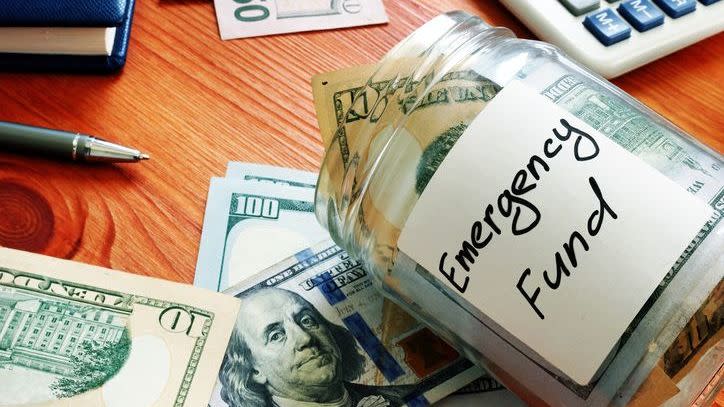I’m 64 ½ and have been retired for a little over a year. I’m receiving Social Security benefits, a little early, but haven’t touched my savings other than withdrawing $10,000, which I’ve placed in a high-interest savings account as an emergency fund. Would it be wise to use some of that money to supplement my or my wife’s 2023 IRA contribution and then continue to withdraw small amounts over the next few years to take the emergency fund to the next level? We have about $1.2 million between our two IRAs.
–Tom
Congratulations on your retirement, Tom. Whether or not you should use IRA withdrawals to build your emergency fund may depend on how dependent you will be on your IRAs for future income. Let’s go through a few things to keep in mind. (And consider talking to a financial advisor if you have similar questions about your retirement plan.)
Supplement your IRA contributions
First, let’s see if you can even make IRA contributions. You’ve been retired for just over a year and have made no mention of any other part-time work you’ve done since then. So it sounds like your income comes solely from Social Security and possible IRA withdrawals. If so, you cannot make an IRA contribution (unless your wife is still employed and has enough income to make a contribution for your spouse), since IRA contributions must come from earned income.
Assuming you can contribute, let’s think about the idea of withdrawing from your IRA and then putting it back into your wife’s account and then taking it out again. This is most likely an unnecessary series of steps that do nothing for you. If it makes sense to withdraw from your IRA to build your emergency fund, it stands to reason that it doesn’t make sense to withdraw from your emergency fund to put it back into your IRA. (Talk to a financial advisor if you need help simplifying your own financial plan in retirement.)
Your emergency fund


For early retirement, the standard rule is that you should set aside enough money to cover three to six months’ living expenses. While that may still be enough for some retirees, it’s important to note that the main reason for the three to six month period (loss of income) is different now that you’re retired. A loss of income doesn’t seem to be much of a problem since you seem to be living solely on your Social Security benefits. As a result, you may be able to get by with a smaller emergency fund than other retirees.
Also consider the idea that if you can reasonably expect to live on Social Security for the rest of your life, with no planned withdrawals from your IRA, then your IRA is essentially already one big emergency fund (although you will have to) . plan to take RMDs later). Having $10,000 in a high-yield savings account can be easy enough if you don’t plan on making many withdrawals from your IRAs.
However, if you plan to rely more on IRA withdrawals in the future, you may want to consider building your emergency fund well above $10,000. That’s because you are mainly exposed to what is known as sequence risk retiring early and having cash on hand can mitigate this. Sequence risk refers to the dangers of making withdrawals during market downturns, when your portfolio is likely to be worth less. If the market falls, you will have to liquidate more of your holdings to meet your income needs, depleting your assets faster and shortening the life of your portfolio.
Although loss of income is the main reason you have an emergency fund during your working period, sequence risk is one of the top reasons to have an emergency fund in retirement. If you’re already retiring, it may be good to set aside enough money to cover a year’s worth of expenses, and possibly even more. This protects you from having to withdraw your accounts during a market downturn, giving them more time to recover. (A financial advisor can help you navigate the sequence risks and other risks you may face in retirement.)
Withdrawing from an IRA to build an emergency fund


Whether you decide you need a large or small emergency fund, also realize that you don’t necessarily need to withdraw all that money from your IRA. You can always designate a portion of your IRA as an emergency fund and place it in the appropriate interest-bearing investments. In practice, it can help to transfer some of your balance to another IRA and designate that entire IRA as part of your “emergency fund,” just to keep things organized. For example, imagine you need $50,000 to cover one year of living expenses. Maybe you keep the $10,000 in your high-yield savings account and designate $40,000 in your IRA as a supplemental emergency fund.
However, taxes are the biggest bottleneck. You will be taxed on your IRA withdrawal whenever you use it, whether now or later. On the other hand, the interest you earn on the money in your savings account will also be taxed along the way.
This doesn’t mean you should not have to withdraw money from your IRA and set aside in your emergency fund. However, taxes are something to think about. Scheduling your withdrawals to minimize your tax liability over time can save you some money. (And if you need help structuring your IRA withdrawals or managing your tax liability, consider working with a financial advisor.)
In short
Your retirement emergency fund is intended to protect you against unexpected expenses, investment losses and tracking risk. Consider the nature of your retirement income. The less secure your income is or the more you rely on withdrawing investments, the more you may want to keep in an emergency fund. Either way, moving money in and out of your IRA at the same time probably won’t help you.
Retirement planning tips
-
Calculating how much income you need to generate when you stop working is a crucial part of your retirement planning. T. Rowe Price recommends starting with a target income replacement rate of 75%. This means that withdrawals from your retirement account, Social Security benefits, and other sources of income must total 75% of your pre-retirement income. From there, you can adjust this percentage up or down based on your savings rate over your career, as well as your expected expenses.
-
A financial advisor can help you draw up a comprehensive retirement plan. Finding a financial advisor does not have to be difficult. SmartAsset’s free tool matches you with up to three vetted financial advisors serving your area, and you can have a free introductory meeting with your advisors to decide which one you think is right for you. If you’re ready to find an advisor who can help you achieve your financial goals, get started now.
-
Have an emergency fund on hand in case you encounter unexpected expenses. An emergency fund should be liquid – in an account that is not at risk of significant fluctuations like the stock market. The trade-off is that the value of liquid cash can be eroded by inflation. But with a high-interest account, you can earn compound interest. Compare savings accounts from these banks.
Brandon Renfro, CFP®, is a financial planning columnist at SmartAsset, answering reader questions about personal finance and tax topics. Do you have a question that you would like answered? Email AskAnAdvisor@smartasset.com and your question may be answered in a future column.
Please note that Brandon is not a participant in the SmartAsset AMP platform, nor an employee of SmartAsset, and has received compensation for this article. Questions may be edited for clarity or length.
Photo credit: ©iStock.com/designer491, ©iStock.com/triloks
The post Ask an Advisor: We Have $1.2 Million in IRAs and Only $10,000 in Cash. Should we use IRA withdrawals to build our emergency fund? first appeared on SmartReads by SmartAsset.







